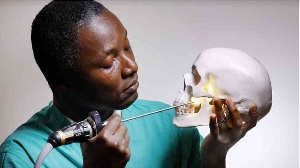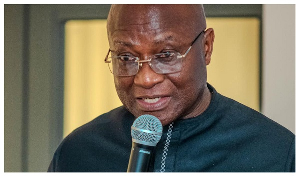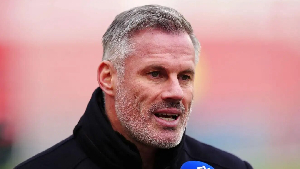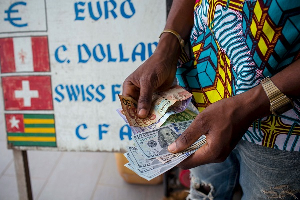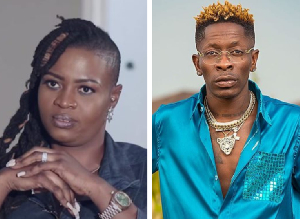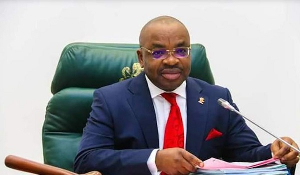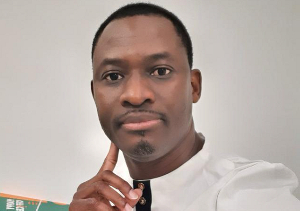“My interest in medicine officially began when I was about ten years, although I had already developed a feel for the language and protocols of healing from watching my father,” writes Dr. Kofi Boahene (Boahene, xi) in his recently released spellbinding memoir “However Far the Stream Flows.”
Dr. Boahene, a recipient of the prestigious “Jack R. Anderson Prize for Scholastic Excellence (2005)” in recognition of “attaining the highest score nationally on the American Academy of Facial Plastic and Reconstructive Surgery certification exam” (see the website of Johns Hopkins University; Boahene(p. 201) is a widely respected and influential Ghanaian-born American Associate Professor of Otolaryngology, Head and Neck, at Johns Hopkins.
Johns Hopkins is also the academic and research home of world-famous neurosurgeon Dr. Ben Caron, as well as of one of the most influential and competitive research pioneers of Baby Blue Syndrome, Vivien Thomas, all of whose wide-ranging corpus of topical publications and writings in the public domain this reviewer has closely and passionately devoured with characteristic humility under a welcoming umbrella of determined, unruffled and effortless curiosity.
Thomas’ autobiography “Partners of the Heart” is a must-read while the film “Something the Lord Made,” based on his struggles and achievements (McCabe, 2007), is a must-see. Dr. Boahene is equally correct to note that “Thomas had a gift for the work and a brilliant mind for research” (Boahene, p. 199).
Moreover, like Drs. Carson’s enthralling “Gifted Hands” and Asante’s “As I run Toward Africa,” Dr. Boahene’s “However Far the Stream Flows” is certainly bound to impact human psychology in many important, unexpected ways—and to add to the rich panorama of inspiring libraries of influential memoirs, as it captures the limitless gamut of the highly charged emotional rhythm of complex odysseys circumscribed by the dashing whirlwind of personal challenges, otherwise expressly descriptive of the sheer will of the human spirit to succeed in life in the face of the unrelenting odds of manufactured—mostly anthropogenic—circumstances, and of unforeseen encumbrances.
And yet, perhaps, some of the most indispensable and impressive highlights of Dr. Boahene’s meandering journey in the underground chambers of life are not unique to the daring character of his globetrotting experience, interestingly given also that his kind of bold yet characteristically simplistic storytelling is denied the intrusive shine of grudging affectation, prideful bravado, and intellectual awkwardness. “I’m hardly unique in this,” he writes (Boahene, p. 22). Not many successful and celebrated academics and scientists can come across as naively candid and truthful as Dr. Boahene.
This is because he is a master of weaving the basket of his personal odyssey in such a way as to keep his niche audience, like this reviewer, irreversibly tethered to an awe-inspiring parallax of rapt admiration—if not in sheer delight of uninterrupted intellectual fixture. Dr. Boahene is indeed the Pelé, the Maradona, or the Muhammed Ali of storytelling, a statement not meant to patronize his writing dexterity per se, although he no doubt possesses an admirable, even profound pedigree of writing style and high caliber diction pleasant to the reading eye, for he deserves an enviable place in the pantheon of great African writers.
Still, some of us have more complex immigrant stories to tell the world than anything our inquiring tentacles picked up from the edgy pages of “However Far the Stream Flows,” a story we hope to tell someday.
Perhaps the most important question anybody might want to ask is, How did Dr. Boahene manage to climb to the very pinnacle of enviable scientific and academic accomplishments from the humble depths of his roots, in spite of the many intertwined encumbrances and unnerving impediments positioned along his path to his dreamed designation of self-actualization—by the “invisible hand” of nature and destiny?
Of course, this is not a thoughtful question he answers within an emotive gridlock of sweeping bulkiness in situ. Rather, it is the kind of curious inquiry he painstaking confronts as part of his signature narrative—which he carefully and intermittently weaves into the interrelated fabric of his otherwise sublime narrative infrastructure throughout the full plastic gamut of his edifying memoir.
The making of a world-class surgeon and scientist
A conducive learning environ, disciplined and doting parents, a healthy non-ephebiphobic culture of primal curiosity and openness, a highly completive preparatory and secondary education, a strong sense of situational circumspection, studiousness, tactical flight from negative peer pressure, industry, self-awareness, an enforced domestic culture of chastity, and a reading culture greeted Dr. Boahene’s developmental psychology—a process clearly defined by the humble roots of his formative social ecosphere which, itself, is meticulously shaped by and concretized through the complex functional analysis of his natural inquisitiveness and focused studiousness. He confirms our close reading and grasp of this aspect of his formative upbringing when he wrote (Boahene, p. 70):
“My choices were informed by the way my parents raised me—with an unwavering faith in God that a path had been designed for me and if I stayed on it, I would succeed in my goals. ‘That path did not include breaking rules’ (our emphasis).”
However, unlike others who are strongly opposed to a supreme deity as the shaper and mover of the fortunes and misfortunes of mortals, we will not in any way dismiss out of hand his abiding—or absolute faith—in the directional oversight of God as the sole driving force behind his cornucopia of scientific accomplishments as we all have what drives us to aspire to heights of personal success, much as we have already done in the special cases of scientist and geneticist Francis Collins, of neurosurgeon Ben Carson, and arguably of one of Africa’s and the world’s most complex men of letters, Noble Laureate Wole Soyinka, a writer most of whose collections of difficult writings we have devoured with relative ease of comprehension. Granted, expecting others to respect our personal choices and preferences is as important as respecting Dr. Boahene’s personal beliefs merely for its own sake. Listen to him again in his words (Boahene, p. 22):
“Ghanaian parents who aspire for their children to become professionals are partial to medicine or law since those are the most respected and accessible. My parents began to lobby me when I was about five or six, but I resisted the idea for a long time because I found the sight of blood so unnerving.
“A voracious reader, I often spent hours leafing through a set of encyclopedias that my father had bought me for a birthday. In spite of my fear of blood, when I read the entry for The Mayo Clinic I was so inspired that the next day I told my friends I would work there when I was grown up.”
As a child growing up therefore, Dr. Boahene assumed the healthy tensions between his parents’ expectations for him and his own innate fears and preferences, his neonate psychoanalytic expectations. “Growing up in Ghana has been a great blessing and I wouldn’t trade it for all the advantages in the world. Like the stream that never forgets its source, my cultural experiences have been and continue to be a constant source of inspiration,” he reminisces nostalgically (Boahene, p. 204).
In other words those covariates of interacting social and cultural forces are behind the optimal eventuation of the highly competitive, formulaic academic person of Dr. Boahene. He paraphrases, for instance, an advice his father once gave him growing up (Boahene, p. 210): “If I worked hard and took good care of people, I believed the good name would follow…” Elsewhere he acknowledges himself being (Boahene, p. 42) “an aspiring African raised in a generally optimistic society,” while also acknowledging the profound influence of his mother on his character development (Boahene, p. 139).
Great minds are usually products of incubating experiential paradoxes and damning challenges which are more often than not capable of resuscitating the latent resources and forces of competitive inventiveness, and of reorienting those buried crude talents towards the advancing compass of personal refinement and growth, of social progress and humanism, including the landscape of human civilization itself, and certainly the academic person of Dr. Boahene is no exception in this progressive grand schemata of intellectual explosion, a personable academic and astute intellectual who is also an embodiment of ingenuity. He writes in this regard (Boahene, p. 194-195):
“What I am most proud of are some of the innovative procedures I have been able to pioneer and others I have refined that go beyond the face and inside the cranium. These often involve removing tumors and fixing other medical conditions that would otherwise lead to blindness or an early death.
“It is very fulfilling when I can rewire a face that has lost the ability to smile or restore facial expression in a child born with undeveloped facial nerves.”
Some critical perspectives
Dr. Boahene is indeed a beautiful mind, like Toni Morrison and Vivien Thomas and Drs. Ama Mazama, Molefi Kete Asante, Ben Carson, Cheikh Anta Diop, Kofi Kissi Dompere, Victor Lawrence, W.E.B. Du Bois, Yaw Nyarko, Francis Allotey, and Theophile Obenga—to name but a few, all of whom—and many more—we have profiled for our international readers. Each of these men and women was and still is variously shaped by the challenging cultural, political, moral, social, and economic paradoxes of the times contemporaneous with his/her unique evolving intellectual topography, and also by the variegated environments they grew up in, and which their invigorating intellectual contributions, in turn, have impacted upon, thereby enriching the bounded totality of the human experience and of improving certain crucial aspects of the human condition.
Thus no defining typology of the human mind evolves in an exclusive topological cauldron of absolute nothingness across the general contours of the natural evolution of human consciousness because, in theory, it is our expectation that it subsists on a primordial innatist ontology, which, if we could hazard a guess, we will say makes for the defining intrinsic charactorology of individual and social idiosyncrasies. There is, however, no doubt in our minds that this lukewarm attempt on our part at a unified theory of psychogizing the intricate and not-so-determinate character of mental idiosyncrasies may have been pushed beyond the pale of solidified conceptual conglutination, for lack of a better expression. This is understandable to an extent.
That is to say, regardless of the foregoing, the relativized evolutionary mapping of the human mind to the environment shapes the defining charactology of the environment and is itself, in turn, shaped by the mischievous vicissitudes and calculating playfulness of the environment. Therefore in a more radical sense we shall posit that the human mind, the environment, and reified consciousness exist in a seamless continuum of syllogistic antagonism, even of the high rank of syllogistic symmetry, rather on account of the strange phenomenological miscegenation between the capable reach of existential inquiry and the seeming elastic finiteness of human cognition.
Perhaps no one individual exemplifies this powerful phenomenological language of complex existential mentation than the academic person of the polyglot Dr. Boahene. The sophisticated, exotic language—and dashing, natural flair—of his riveting storytelling aptitude speaks to this ennobling phenomenology of bounteous, competitive inventiveness in relation to the captivating peculiarity of psychological resourcefulness.
This somehow makes it possible to visualize, conceptualize, or zoom in on a dataset of profound thinkers who are linked together in an embracing familiarity of critical thinking, of course of the kind duly and strongly underpinned by a spatial sciography of rigorous scientific training. For instance, we can recognize a useful conflation between Drs. Boahene and Carson in the form of the former’s “cross-facial graft” (Boahene, p. 222) and the latter’s “plasticity” (Carson, 1996).
We should also be able to see some essential facets of their overlapping work collapse into either those of neuroscientist Antonio Damasio (Damasio, 2003), or of Mexican-born American neuroscientist Alfredo Quiñones-Hinojosa (Quiñones-Hinojosa & Rivas, 2011), a well-respected scientist and neurosurgeon with whom Dr. Boahene has collaborated in the operating room on many occasions, a key narrative fixture of his personal historiography. Regarding this important productive collaboration in the operating room, Dr. Boahene writes poignantly and forthrightly (Boahene, p. 205):
“Today we increasingly use a minimally invasive endoscopic procedure in which instruments attached to a tiny camera lens are inserted through natural openings—the nose, mouth, a small hole just above the eyebrow, or by going in through a corner of the eye socket. The goal is to do as little damage as possible to the person’s appearance while getting to the site and removing the diseased tissue. ‘My Hopkins neurosurgery colleague, Dr. Alfredo Quiñones-Hinojosa, and I have performed these procedures hundreds of times to remove tumors and repair brain fluid leaks’ (our emphasis).”
Dr. Quiñones-Hinojosa rose from the sinking depths of a migrant farm worker to become one of the world’s most respected, influential and celebrated neurosurgeons and scientists. Dr. Boahene has also collaborated with tissue engineers to rebuild or reconstruct faces damaged by birth defects and cancer (Boahene, p. 202).
On the other hand what is equally mindboggling is the fact that, Dr. Boahene’s unexpected yet distinguished and progressive transmigration from a little inquisitive boy who could dexterously fashion a moving miniaturized or toy car from a random miscellany of metal scraps, and was to become a temporary apprentice mechanic in the US prior to entering medical school (Boahene, p. 76-77), to a celebrated world-class medical academic and scientist with a specialty in otolaryngology and a subspecialty in facial reconstructive surgery—skull base surgery (Boahene, p. 228), is a narrative worth celebrating and telling to a wide audience made up of a sea of humanity.
What Dr. Carson titularly calls “gifted hands,” and which Dr. Boahene otherwise refers to as “a steady hand” (Boahene, p. 171), has been one of the latter’s greatest—if not priceless—assets following his veterinary training in the now-defunct Soviet Union—the city of Krasnodar in Russia specifically. Dr. Boahene counts “artistic instincts” and “a good eye” among those priceless gifts an otolaryngology surgeon should acquire in order to become competitively successful in the field (Boahene, p. 171).
Opinions of Tuesday, 9 January 2018
Columnist: Francis Kwarteng





